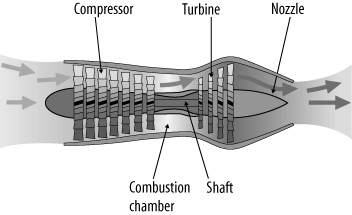046
Farnborough Air Sciences Museum, Farnborough, England
 51° 16′ 56.28″ N, 0° 45′ 10.8″ W
51° 16′ 56.28″ N, 0° 45′ 10.8″ W
![]()
![]()
![]()
Making Aircraft Move
The Farnborough Air Sciences Museum has a collection of early aviation equipment focusing on the science of flying. It’s a small and concentrated dose of aircraft and aviation equipment, based on an almost discarded collection of historical artifacts from the Royal Aircraft Establishment at Farnborough.
The most important exhibit is an original jet engine built from Sir Frank Whittle’s design. Whittle patented the jet engine in 1930, and in 1941 the first British jet-powered aircraft, the Gloster E.28/39, was flying. The W2/700 jet engine (see Figure 46-1) on display is the ancestor of all modern jet engines and was the first production jet engine in Britain.

Figure 46-1. Whittle W2/700 jet engine
There’s an early afterburner (called at the time an “augmenter”) that was designed to fit behind the Whittle engine and generate extra thrust by injecting fuel into the hot gases escaping from the jet engine.
There’s also a display of a helicopter rotor, which explains how the blades rotate and pitch to provide lift and motion.
The museum has a significant collection of wind tunnel models, including models that illustrate the performance of the Concorde at low speeds. There’s a collection of shock cones used for wind tunnel research of air intake shapes for supersonic aircraft. There’s also a working wind tunnel demonstration.
And of course, the museum has a collection of aircraft. There’s the cockpit of a 1971 Hawker Siddeley Trident passenger jet—the Trident was a pioneering aircraft because of its speed (Mach 0.88) and its ability to land “blind” using automatic landing equipment. The cockpit has been restored, with all the instruments working, and is set up for visitors.
There’s also a Sea Harrier “jump jet” capable of vertical takeoff and landing, a British Lightning T5 jet fighter from the 1960s that’s capable of Mach 2, and a Puma Helicopter.
The museum is entirely run by expert volunteers, and many of them are on hand to explain the exhibits.
Practical Information
The museum is open on the weekends, and entrance is free of charge. You can find full details from the Farnborough Air Sciences Trust website at http://www.airsciences.org.uk/.


